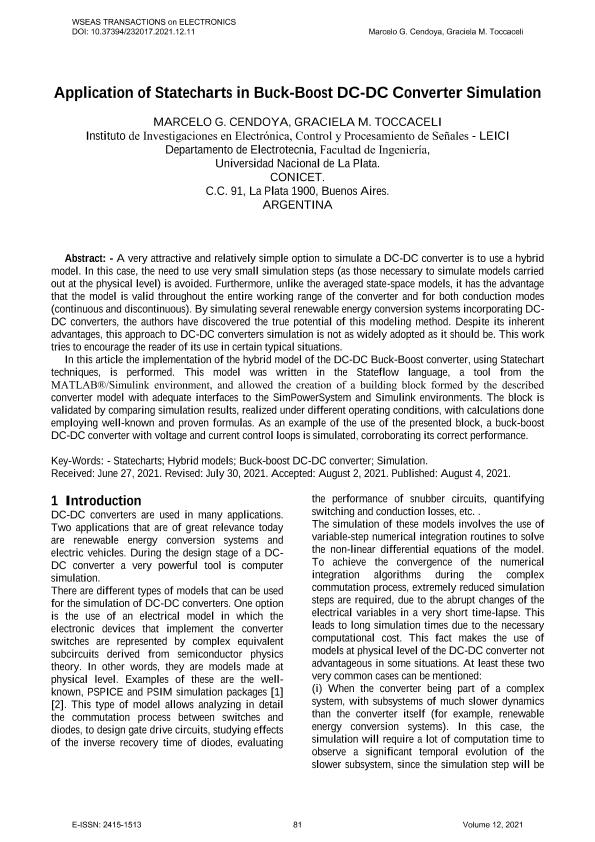Mostrar el registro sencillo del ítem
dc.contributor.author
Cendoya, Marcelo Gustavo

dc.contributor.author
Toccaceli, Graciela Mabel

dc.date.available
2022-10-19T12:47:13Z
dc.date.issued
2021-08-04
dc.identifier.citation
Cendoya, Marcelo Gustavo; Toccaceli, Graciela Mabel; Application of Statecharts in Buck-Boost DC-DC Converter Simulation; World Scientific and Engineering Academy and Society; WSEAS Transactions on Electronics; 12; 4-8-2021; 81-88
dc.identifier.issn
1109-9445
dc.identifier.uri
http://hdl.handle.net/11336/173898
dc.description.abstract
A very attractive and relatively simple option to simulate a DC-DC converter is to use a hybrid model. In this case, the need to use very small simulation steps (as those necessary to simulate models carried out at the physical level) is avoided. Furthermore, unlike the averaged state-space models, it has the advantage that the model is valid throughout the entire working range of the converter and for both conduction modes (continuous and discontinuous). By simulating several renewable energy conversion systems incorporating DC-DC converters, the authors have discovered the true potential of this modeling method. Despite its inherent advantages, this approach to DC-DC converters simulation is not as widely adopted as it should be. This work tries to encourage the reader of its use in certain typical situations. In this article the implementation of the hybrid model of the DC-DC Buck-Boost converter, using Statechart techniques, is performed. This model was written in the Stateflow language, a tool from the MATLAB®/Simulink environment, and allowed the creation of a building block formed by the described converter model with adequate interfaces to the SimPowerSystem and Simulink environments. The block is validated by comparing simulation results, realized under different operating conditions, with calculations done employing well-known and proven formulas. As an example of the use of the presented block, a buck-boost DC-DC converter with voltage and current control loops is simulated, corroborating its correct performance.
dc.format
application/pdf
dc.language.iso
eng
dc.publisher
World Scientific and Engineering Academy and Society
dc.rights
info:eu-repo/semantics/openAccess
dc.rights.uri
https://creativecommons.org/licenses/by/2.5/ar/
dc.subject
Statecharts
dc.subject
Hybrid models
dc.subject
Buck-boost DC-DC converter
dc.subject
Simulation
dc.subject.classification
Ingeniería Eléctrica y Electrónica

dc.subject.classification
Ingeniería Eléctrica, Ingeniería Electrónica e Ingeniería de la Información

dc.subject.classification
INGENIERÍAS Y TECNOLOGÍAS

dc.title
Application of Statecharts in Buck-Boost DC-DC Converter Simulation
dc.type
info:eu-repo/semantics/article
dc.type
info:ar-repo/semantics/artículo
dc.type
info:eu-repo/semantics/publishedVersion
dc.date.updated
2022-09-21T16:53:38Z
dc.identifier.eissn
2415-1513
dc.journal.volume
12
dc.journal.pagination
81-88
dc.journal.pais
Grecia

dc.journal.ciudad
Atenas
dc.description.fil
Fil: Cendoya, Marcelo Gustavo. Consejo Nacional de Investigaciones Científicas y Técnicas. Centro Científico Tecnológico Conicet - La Plata. Instituto de Investigaciones en Electrónica, Control y Procesamiento de Señales. Universidad Nacional de La Plata. Instituto de Investigaciones en Electrónica, Control y Procesamiento de Señales; Argentina
dc.description.fil
Fil: Toccaceli, Graciela Mabel. Consejo Nacional de Investigaciones Científicas y Técnicas. Centro Científico Tecnológico Conicet - La Plata. Instituto de Investigaciones en Electrónica, Control y Procesamiento de Señales. Universidad Nacional de La Plata. Instituto de Investigaciones en Electrónica, Control y Procesamiento de Señales; Argentina
dc.journal.title
WSEAS Transactions on Electronics
dc.relation.alternativeid
info:eu-repo/semantics/altIdentifier/url/https://wseas.com/journals/articles.php?id=468
dc.relation.alternativeid
info:eu-repo/semantics/altIdentifier/doi/http://dx.doi.org/10.37394/232017.2021.12.11
Archivos asociados
